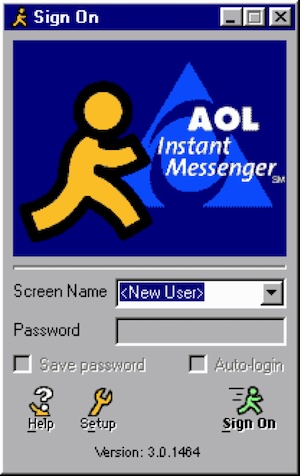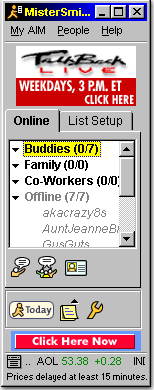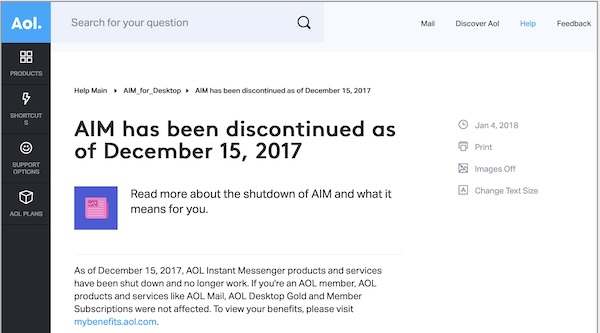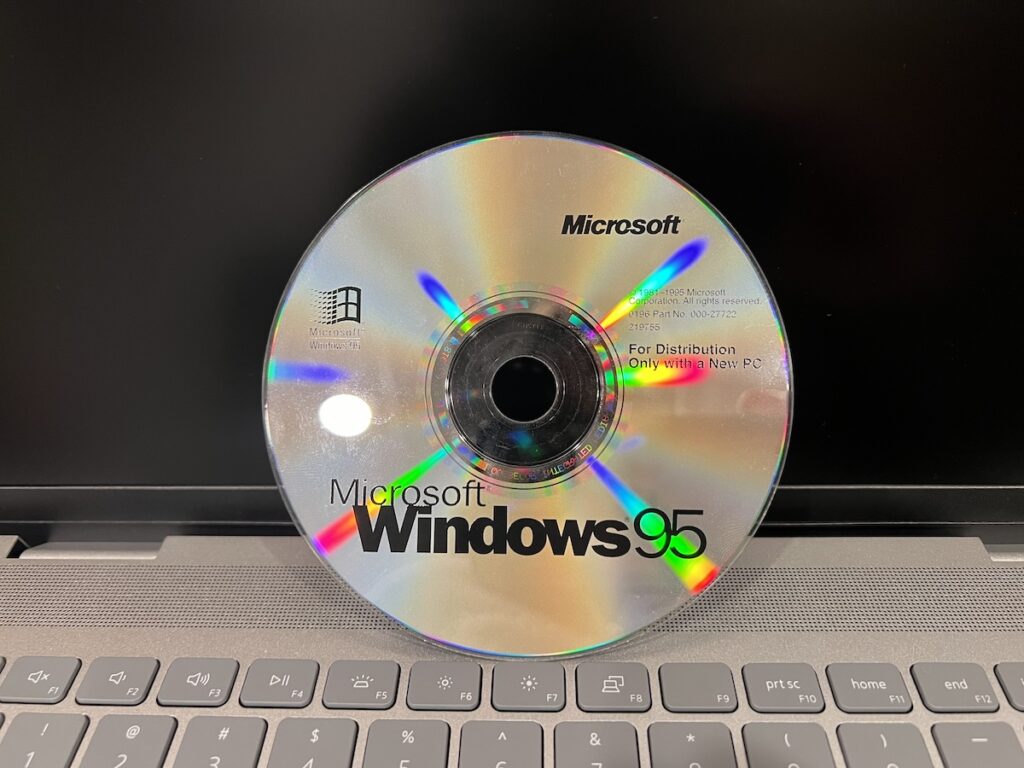Do you remember the days of hurriedly finishing your homework so you could log on to AIM and chat the night away? Ah, those were the days, weren’t they?
AOL Instant Messenger, or AIM as we fondly called it, wasn’t just another tech fad; it was a cultural phenomenon that defined an era of digital communication.
Think about it – this was a time when the internet was still stretching its legs, and here comes AIM, making us feel like we were all part of something new and exciting.
Let me take you on a trip down memory lane, back to the late 90s and early 2000s. This was a time when our bulky desktops were our gateways to the world, and that familiar door-opening sound of AIM signified that our friends were just a click away.
AIM Sound When a Friend Came Online
We’d spend hours chatting, away from the prying eyes of our parents, creating quirky screen names and even quirkier away messages. It was our little escape, our digital playground.
But AIM was more than just a chat platform; it was a pioneer, a trailblazer in the world of online communication. It laid the groundwork for the social media and messaging apps we can’t live without today.
So, grab your favorite snack, settle in, and let’s rewind the clock. We’re going back to explore the forgotten history of AIM, the platform that taught us the art of online conversation, one ‘LOL’ at a time.
The Dawn of AIM: How It All Began
So, let’s set the stage, shall we? The year is 1997. ‘Titanic’ is breaking box office records, and Tamagotchis are all the rage.
In this whirlwind of 90s pop culture, a little something called AOL Instant Messenger quietly made its debut. But, oh boy, it wasn’t going to stay quiet for long.
Imagine the internet back then – it was like the Wild West, a new frontier. People were just getting the hang of emails and web browsing.
Then along comes AIM, introducing us to the thrill of real-time online chat. It was a game-changer. Suddenly, you could talk to anyone, anywhere, instantly – mind-blowing, right?
The Innovation Behind the Chime
Let’s talk tech for a sec. AIM wasn’t just another messaging software; it was a trailblazer. It had this cool, user-friendly interface that made online chatting a breeze.
You had your ‘Buddy List’ where you could see if your friends were online. Green dot? Time to send them a message!
And let’s not forget those iconic sounds – the door opening and closing as buddies came and went. The chimes when you sent and received a message. These were the little things that made AIM special.
But AIM wasn’t just about chatting. It allowed us to express ourselves in ways we never could before online.
Those quirky screen names we chose? They were more than just names – they were our digital alter-egos.
And those away messages? Pure poetry, sometimes hilarious, sometimes cryptic, always a peek into our young souls.
AIM Sound When a Friend Came Online
AIM Sound When a Friend Went Offline
AIM Sound When You Send a Message
AIM Sound When You Receive a Message
Ahead of Its Time? Absolutely
In a way, AIM was ahead of its time. It was doing social networking before social networks were even a thing. Think about it – you had your list of friends, you chatted, shared snippets of your life through away messages.
Sounds familiar, right? It’s like AIM laid the groundwork for the Facebooks and Twitters of the world.
And remember, all of this was happening when most of us were still on dial-up internet. That’s right, the same internet that wouldn’t let you chat and talk on the phone at the same time.
AIM worked around these limitations to keep us connected, making it nothing short of a technological marvel for its time.
So there we have it – the birth of AIM and its early innovations. It wasn’t just a messenger; it was the messenger that shaped the future of online communication.
More Than Just a Chatroom
It wasn’t just about sending messages back and forth. No, AIM did something extraordinary – it created a whole new culture, a digital culture that many of us hold dear in our nostalgic hearts.
A New Language Was Born


First off, AIM practically invented a new language. BRB, LOL, ROFL – these terms are commonplace now, but back then, they were revolutionary.
It was like learning a secret code that only fellow AIM users understood. This language wasn’t just about being cool; it was practical.
Remember, we were typing on keyboards that clacked louder than our teachers’ chalk on a blackboard. Short forms were a necessity!
The Art of the Away Message


Then there were the away messages. These weren’t just “I’m not here” notifications; they were a canvas for creativity and expression.
Some used song lyrics to convey their mood, some crafted witty one-liners, and others left cryptic messages that had us guessing.
It was our first taste of ‘status updates’ – a way to broadcast our feelings, thoughts, and whereabouts before the era of social media.
Digital Identity and the Screen Name


Your screen name was your identity. It was how you were known in the AIM universe.
Picking the right one was crucial – it had to be cool, unique, and sometimes cryptic. It wasn’t uncommon to spend hours brainstorming the perfect screen name.
This was our first foray into managing a digital persona, a concept that’s second nature to us now in the age of Instagram and Twitter.
The First Social Network?


In many ways, AIM was the precursor to social networking. We had our buddy lists, which were essentially a friends list.
We’d curate this list, adding new friends, managing old ones – it was our own little community. We didn’t just chat; we connected.
AIM was where friendships were forged, sometimes with people we’d never met in person. It was a digital hangout spot, long before the concept of a ‘social network’ was even coined.
Impact on a Generation
For a whole generation, AIM was a rite of passage. It taught us how to communicate in a digital world, how to be present online.
It shaped our early internet experiences and influenced how we interact on the web today. Sure, it was fun and games (and a bit of teenage drama), but in hindsight, AIM laid the foundation for our digital lives.
AIM’s Role in AOL’s Strategy
AIM was more than just a fun messaging app; it was a strategic asset for AOL. It helped the company maintain a strong presence in the rapidly evolving world of online communication.
The platform attracted millions of users, many of whom were young and tech-savvy, a demographic highly sought after by advertisers and businesses.
The late 90s and early 2000s were a time of fierce competition in the online space. AIM stood out not just because of its features but also due to its accessibility and user base.
However, as the internet landscape evolved, so did the competition. Newer platforms began to emerge, offering different or enhanced communication experiences.
One of the key challenges for AIM was staying relevant in a rapidly changing technology landscape. As new platforms emerged, AIM had to continuously innovate to keep its users engaged.
This was not just about adding new features but also about enhancing user experience and maintaining the simplicity that made AIM popular in the first place.
The advent of social media was a turning point for AIM and similar messaging platforms. Social media offered a more integrated and expansive way of online interaction, which started to draw users away from standalone messaging apps.
This shift marked a significant challenge for AIM, as it struggled to maintain its user base in the face of rising social media giants.
Expert Perspectives
Eric Bosco, who helped build AIM, reminisces about the early stages of its development: “It was total skunkworks,” he says, recalling a time when AIM’s potential was yet to be fully recognized.
Bosco also notes the initial business model challenges: “Those features were considered to be a real value proposition…if you’re giving away for free what our paying customers really like, then we’ll lose paying customers,” reflecting on the dilemma of offering AIM as a free service.
Bosco also discusses AIM’s lasting influence: “I think AIM was really the first commercially successful consumer messaging product out there,” and notes its impact on future messaging platforms, including those by Google.
Journalist David Pierce reflects on AIM’s innovative features, such as custom icons and chatbots, and its role in popularizing “internet speak.” “AIM taught me how to LOL, and the subtle difference between ROFL and ROFLMAO. I was always brb-ing, and always jk’ing,” he writes, highlighting AIM’s influence on online communication.
Josh Constine of TechCrunch offers a balanced view of AIM’s history: “Its iconic Away Messages were the ancestor to the modern tweet and status update…But eventually text messaging, Google’s GChat, and Facebook took over, while AIM never fully figured out the shift to mobile”. This encapsulates AIM’s pioneering role and its struggle to adapt to new technologies.


Unfortunately, all good things must come to an end.
The Enduring Influence of AIM in the Digital Age
As we close the chapter on our exploration of AOL Instant Messenger, it’s clear that AIM was more than just a software application. It was a groundbreaking force in the evolution of online communication, a cultural icon of the late 90s and early 2000s, and a significant part of many people’s digital upbringing.
AIM’s influence is deeply woven into the fabric of how we communicate online today. It pioneered many of the features that have become standard in modern digital communication: real-time messaging, personalized profiles, and the concept of status updates.
The simplicity and intuitiveness of AIM’s design laid the groundwork for the user-friendly interfaces we expect in today’s messaging applications.
Beyond its technological impact, AIM holds a special place in the hearts of those who grew up using it. It represents an era of discovery and excitement in the digital world, a time when the internet was still new and full of possibilities.
The nostalgia associated with AIM speaks volumes about its impact on a generation of users.
Moreover, the story of AIM serves as an important reminder of the need for constant innovation and adaptability in the tech industry. As the digital landscape continues to evolve at a rapid pace, the rise and fall of AIM highlights the importance of staying ahead of the curve to remain relevant.
In conclusion, while AIM may no longer be a part of our daily lives, its legacy endures. It helped shape the digital communication landscape and paved the way for the future of online interaction.
As we continue to advance in the digital age, the lessons and memories of AIM will remain an integral part of our collective online journey.



